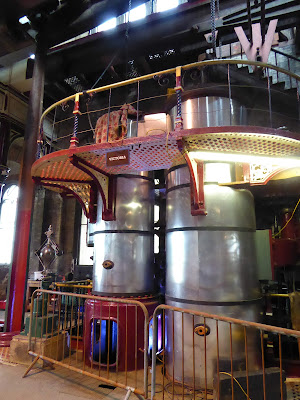The first railway at Crossness was built to deliver materials across the marshes to the pumping station and was a standard gauge of four and a half feet. This one has been recently built by enthusiasts and volunteers just for passengers and is a two feet narrow gauge. I had no idea it was here so it was a very pleasant surprise.
Crossness sewage works was a masterpiece of Victorian engineering with elaborate ironwork.


From 1800 to 1850 London's population increased from 1.1 million to 2.7 million. Disease was rife with over 10,000 Londoners dying from Cholera in the 1853-54 epidemic. Four years later in the hot summer of 1858, the Great Stink, hung over the city. It was so bad that plans were made to evacuate the Houses of Parliament which run alongside the river Thames. The Metropolitan Board of Works gave the task of developing a new sewerage system to its chief engineer, Sir Joseph Bazalgette.
Bazalgette devised a system of three massive intercepting sewers built parallel to the river. They were built underground and diverted the foul sewage water to great holding tanks here at Crossness and another pumping station at Abbey Mills in West Ham. The sewage would be held there and then pumped into the river on the ebbing tide.
Crossness pumping station was opened in 1865 looking magnificent with its colourful ironwork.
Metropolitan Board of Works.
The engine house contained four beam engines by James Watt & Co named Prince Consort, Victoria, Albert and Alexandra. This one is Victoria. The engines had 52 ton flywheels and 47 ton beams and are believed to be the largest rotative beam engines in the world.
An iron staircase led to the upper floor
I'm not a lover of heights and being able to see the ground through the floor always gives me hand sweats and a need to grip any available hand rail.
It was well worth it though to be able to look closely at the decorative ironwork from above.

In 1882, A Royal Commission was appointed to assess the state of the Thames and sewage treatment. The commission's report recommended that untreated sewage should no longer be pumped out into the Thames. In future solid matter would be 'settled out' and disposed of in the North Sea. Six sludge vessels were ordered. The first, the Bazalgette, was commissioned in June 1887. I bet he was thrilled to have a sludge vessel named after him. Dumping sewage in the sea continued for another hundred years until the1990s. By then, Thames Water developed two sludge powered generators at its largest sewage works in Crossness and Barking. Sewage sludge is dried into blocks called (for some unknown reason) cake. These cakes are burned to generate heat and drive a steam turbine which creates electricity.

This is the modern sewage works just along the river from here, where the sewage is burnt to produce electricity.




























For the first four years of my career, I worked as an engineer for the City of Portland's sewer bureau, so your post was very interesting to me. This has got to be the prettiest sewage treatment plant I've ever seen. Portland takes their leftover solid waste, sterilizes it, and sells it as soil conditioner.
ReplyDeleteWhat a great place. For several years I spent the weekend in London for open house. I haven't managed it for the last few years but have been out this weekend for heritage open days which was fun.
ReplyDeleteWonderful shots.
ReplyDeleteA similar concept to Doors Open here.
That is certainly the prettiest sewage area I've ever seen. Great pictures, and I love steam engines, too. :-)
ReplyDeleteIt amazes me that such a utilitarian building was built to be so beautiful too. Thanks for showing us around.
ReplyDeleteAmazing beautiful architecture and I have a thing for iron railings, about the only place we see that here is in cemeteries around some of the older graves but they are quite lovely.
ReplyDeleteI too am amazed at how pretty it is….Love the idea of open buildings…they have that also in Canada.
ReplyDeleteThe engineers had absolutely needed to reorganise the sewage system, given it was an essential part of improving public health. But Joseph Bazalgette designed the pumping station to show that good health and good engineering did not have to be totally ugly and stinky. I imagine that in 1865 Bazalgette already understood that the Victorian London Sewerage system would become a vital industrial heritage site. Go Joseph
ReplyDeleteTo put so many beautiful finishes in that building seems like a waste of money. I'm sure it wasn't open to the public to see at the time, was it?
ReplyDeleteYou did well to take the second floor photos despite your acrophobia.
Wow ! that's the most beautiful pump station I have ever seen ! Real art work for such an ordinary thing !
ReplyDeleteWow! is right ~ Fascinating waste plant with such intricate design and the history too is intriguing ~ Love the red train too ~ Great post and photos ~ Xo
ReplyDeleteLiving in the moment,
A ShutterBug Explores,
aka (A Creative Harbor)
What a beautiful pumping station.
ReplyDeleteSo glad to read they eventually learned how to put the sewage to work for them.
What a charming building. Thank you so much for the history behind this pumping station.
ReplyDeleteA very interesting post. :)
Well, they don't make them like that anymore! Nowadays the money would most likely be spent on meetings and the like, not on beautifying the buildings.
ReplyDeleteFascinating! For the most foul of things -- human waste — a place of such colorful ornateness and beauty was created. And over the ages hardly anyone (except those who worked inside) ever got to see it. Maybe it was compensation for the ugly job those workers had to do! Wonderful that the sludge cakes are now generating electricity rather than polluting the sea.
ReplyDeleteThe decorative ironwork looks amazing.
ReplyDeleteMany thanks for the information and photographs.
All the best Jan